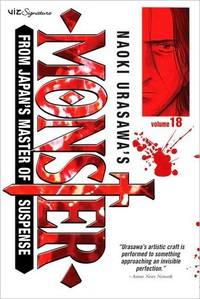Review
by Casey Brienza,Monster
GN 17-18
| Synopsis: |  |
||
Nina at last comes face to face with her twin brother Johan, and she has something important to tell him about the Red Rose Mansion. Unfortunately, her revelation matters for naught because Johan's final gambit is already in play. Tenma, Grimmer, and Inspector Lunge independently converge on Ruhenheim, a town nestled in the remote southern countryside of Germany. An important personage has been hiding out there for years, but more importantly, Ruhenheim is where there is to be an impending disaster that will cinch this story's end. By preying upon the pathologies and paranoia of the townspeople, Johan and his lackeys are going to get them all to massacre each other. Will Tenma and the others be able to stop this dastardly plan—and the fulfillment of Johan's long-cherished, long-concealed desire? |
|||
| Review: | |||
In William Styron's classic novel Sophie's Choice, the titular heroine Sophie is confronted with a terrible choice while imprisoned in a Nazi concentration camp during World War II. The account of this choice and the way in which she ultimately comes to grips—or rather does not come to grips—with it some years later represents the climatic moment of the novel, and its message about the ineffable yet banal nature of evil is both horrifying and unforgettable. I will not spoil either the novel or the manga outright for those readers obsessed with the sanctity of those sorts of things, but it is sufficient for review purposes here to make the following key remarks about the relationship between the two works: Naoki Urasawa has poached the climatic account of Sophie's choice for the climatic concluding image of his own eighteen-volume seinen manga epic Monster. Unfortunately, he changes the narrative perspective, and in so doing he empties the original Styron story of its affective power. That affective power hinges on its demonstration of the ways in which evil can make even innocents complicit in the spread of still more evil. (Yes, I'm being vague on purpose.) Urasawa, in contrast, turns this nightmare of intensification into a prosaic, postwar Japan-style self-pity party whine about victimization. And thus does a self-proclaimed exploration into how human beings turn and are turned into monsters end. It's an end that goes out with a whimper, not a bang…more's the pity. Actually, come to think of it, the whimper in question is a long, anguished wail of agony which Urasawa works into a convoluted neighbor-turning-on-neighbor subplot that fills nearly two whole oversized tankoubon volumes and is about as unnecessarily pseudo-cerebral as this series ever gets. But at least Urasawa makes it fun to read about other peoples' misery. To make a long story short, Tenma, Grimmer, and Inspector Lunge all reach the same conclusion independently: The man known variously as Emile Scherbe, Franz Bonaparta, Klaus Poppe, etc. has been hunkering down for quite a long time in the little German town of Ruhenheim. So, they all head there looking for answers, but what they walk into instead is a very retired Poppe and a bunch of unlikely Johan lackeys who are surreptitiously passing guns out to the townspeople. Next thing you know, it's a war zone. Johan, meanwhile, hovers aloof above the fray, but he has an end in mind that has been thinly foreshadowed for several volumes now—his own annihilation. At Dr. Tenma's hands, presumably. Can Tenma do it? The answer to that question ought to surprise no one. But alas, that is the only thing transparent about Johan; there is nothing satisfactory ever revealed to fully account for his supremely scrambled psyche, not even Nina's belated revelation. In fact, a lot of the basic biographical details around which the entire Monster manga was developed have, after eighteen volumes, become awfully confused. Exactly when, for example, was Johan put in the Kinderheim 511? Was this before or after the incidents at the Red Rose Mansion? Was this before or after the twins meet Tenma for the first time? It's virtually impossible to keep track over such a long haul, and it all just blurs together into one stinky morass of unethical, dehumanizing human experiments. Ironically, this spreading lack of narrative clarity is accompanied by a subtly improved art style on Urasawa's part that, by the end, is both clean-lined, soft-edged, and shot through with a well-expressed compassion for the human condition. Perhaps the evolution is just a reflection of the changing times; illustrations seemingly influenced by 1980s gekiga have gradually become, well, cuter and perhaps a bit more in line with contemporary tastes in kawaii and moé. It's not an inappropriate change, given what is eventually revealed to be Urasawa's basically optimistic outlook on his characters. Anyway, despite its significant flaws, which means that never quite reaches the level of “great literature” (even when borrowing from the real deal), Monster manages to succeed at least as a gripping page-turner right all the way to the end. As long as you don't look too hard for deep meanings or think too hard about whether or not it all makes sense in the end, you're sure to have a rocking good time clinging to the edge of your proverbial seat as Urasawa's heroic creative effort takes its final bow. |
| Grade: | |||
|
Overall : A-
Story : B+
Art : A
+ A readable page-turner with handsome art and a compelling millieu. |
|||
| discuss this in the forum (25 posts) | | |||
| Production Info: | ||
|
Full encyclopedia details about Release information about |
||